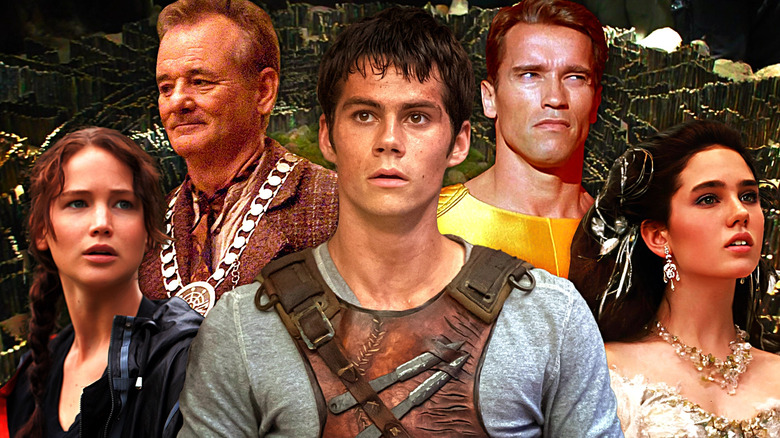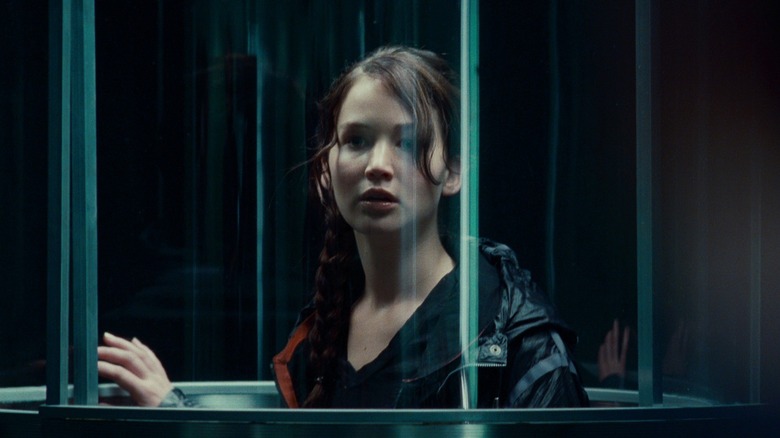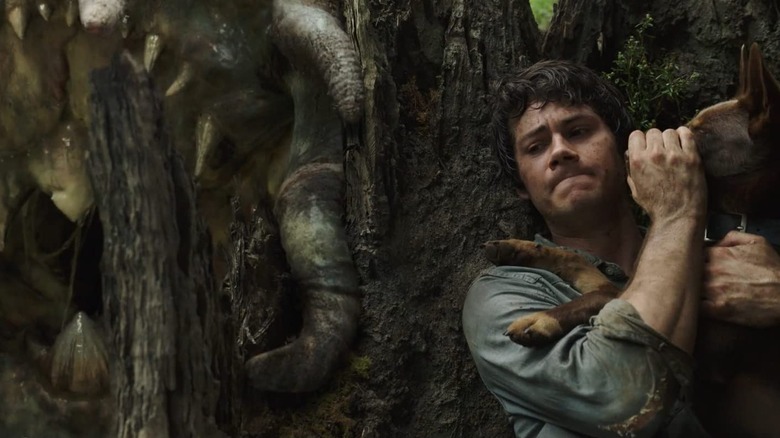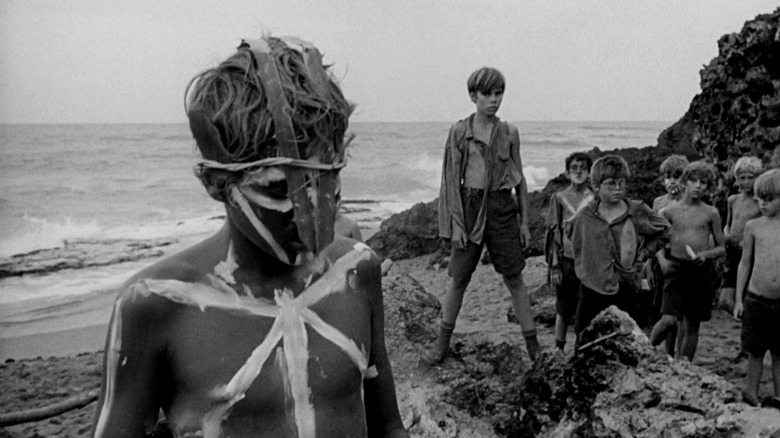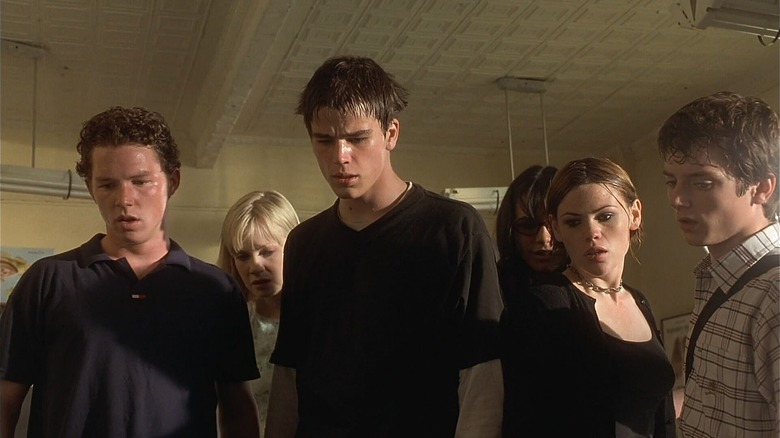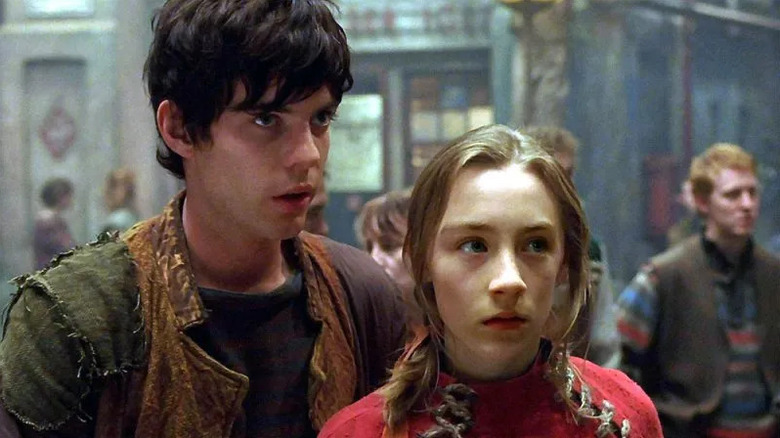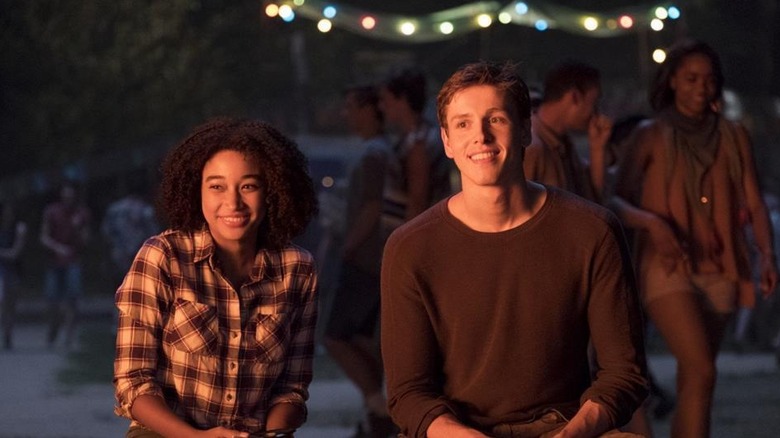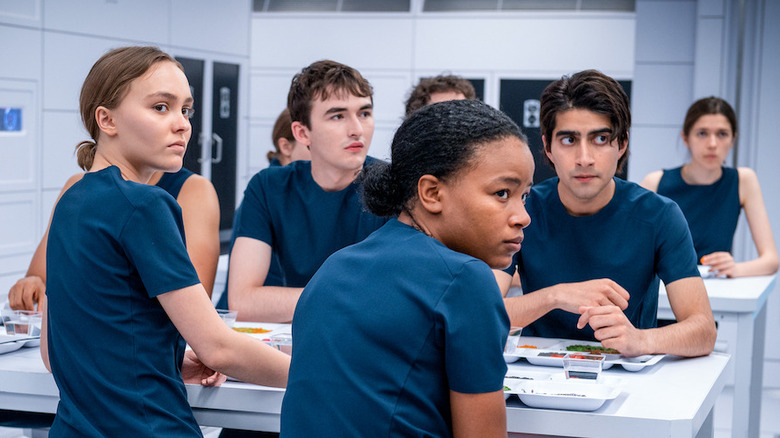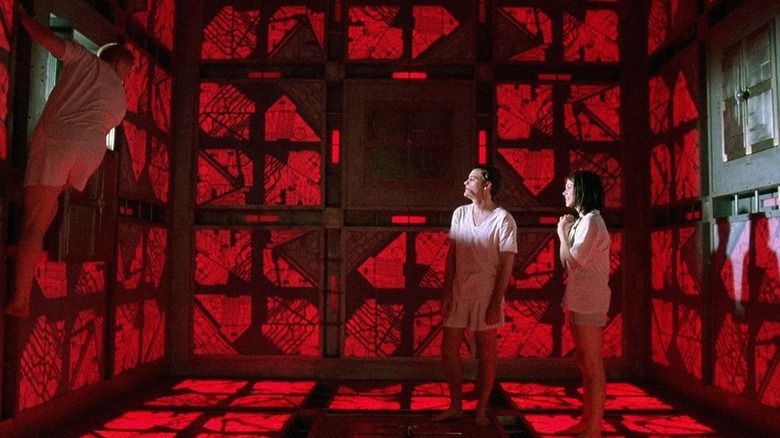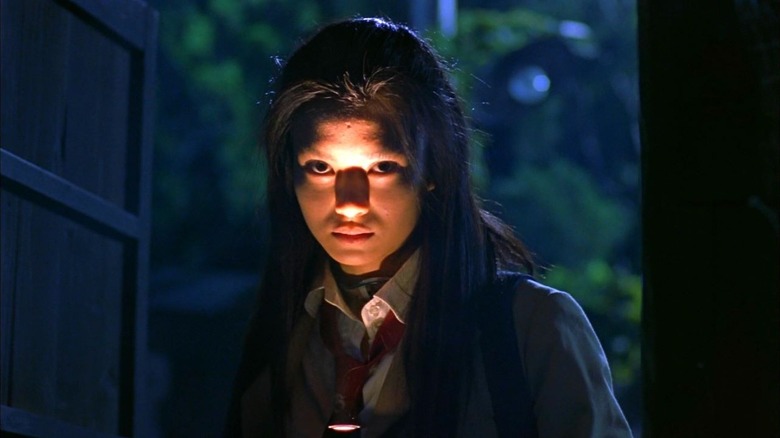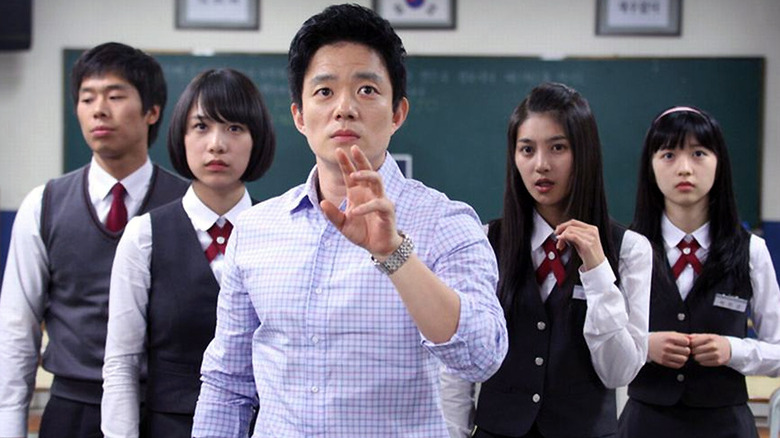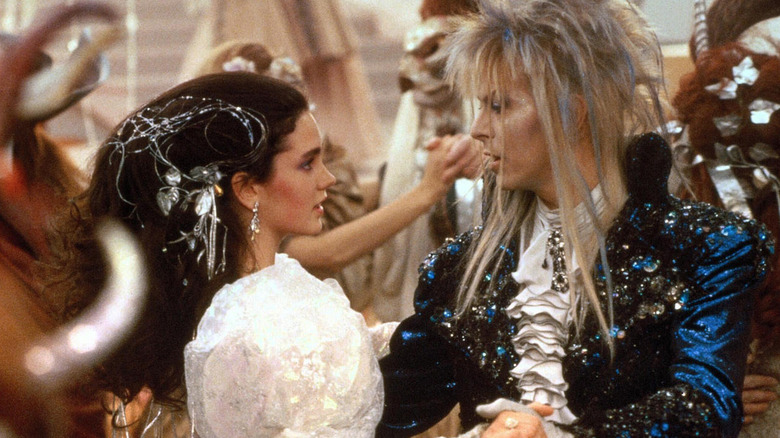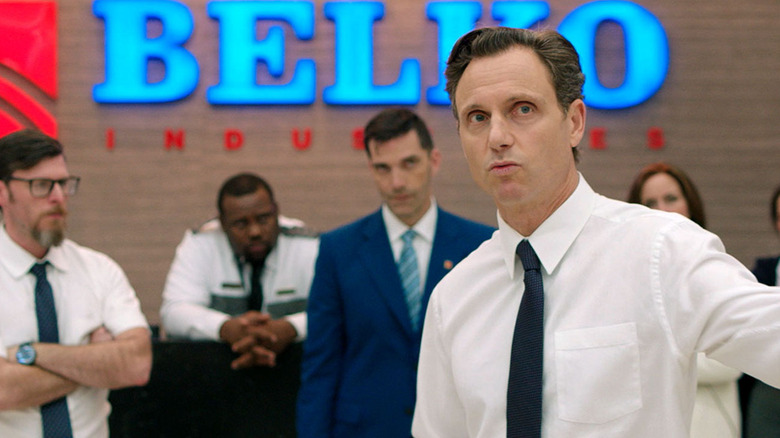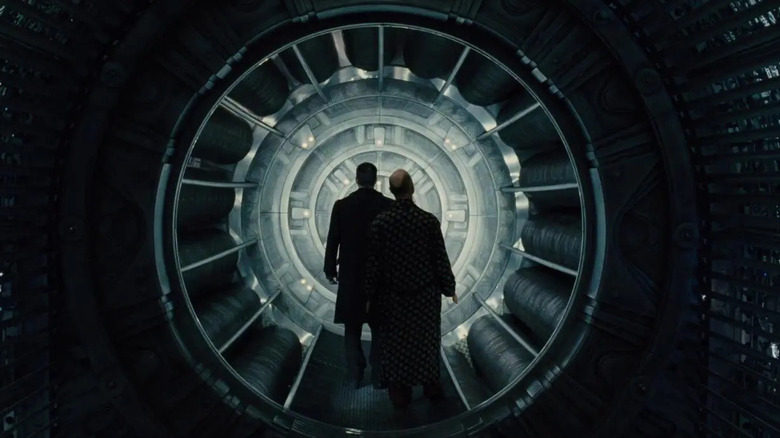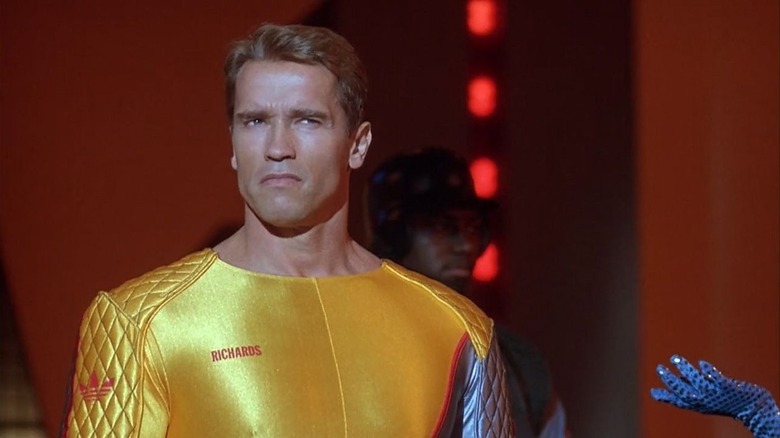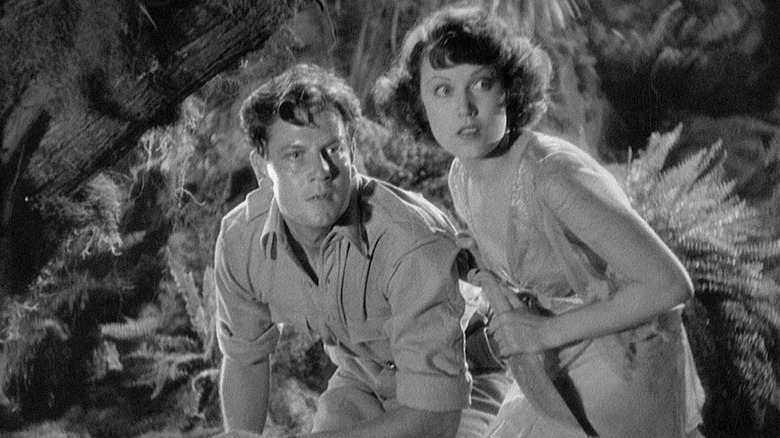15 Best Movies Like The Maze Runner
The 2000s and early 2010s were marked with a boon of young adult books getting adapted into the big screen. This could really be seen as starting with the runaway success of 2001's "Harry Potter and the Sorcerer's Stone" adaptation and its subsequent sequels. However, 2008's "Twilight" movie took things to another level, prompting studios to adapt pretty much any book that preteens were obsessed with. Some of these failed to launch, while others became cemented into the public consciousness, like "Twilight" and "The Hunger Games." but "The Maze Runner" series absolutely belongs in that latter category too.
Out of all the films to come out during the YA craze, "The Maze Runner" had the biggest bang for its buck, grossing $348 million against a relatively paltry $34 million budget. Two film sequels followed with "The Scorch Trials" and "The Death Cure," but it all began with that first story about a group of teens mysteriously stranded outside of a massive maze that seemed to offer their only escape, requiring them to work together to find a way out. Teens rebuilding some kind of civilization amongst a dystopian world is well-trodden territory, but "Maze Runner" capitalized on the moment to become one of the better offerings during the YA boon.
If you still find yourself thinking of Gladers rediscovering their identities, you may be in the market for some similar projects. Here are the best movies like "The Maze Runner" thatt ou should put on your watchlist to gain an even greater appreciation for what the film accomplished.
The Hunger Games (2012)
If you like "The Maze Runner," there's a good chance you're already a fan of "The Hunger Games" series. The first film, in particular, has a similar vibe to "Maze Runner," where a bunch of teenagers are put in a larger-than-life scenario. In this case, they're put onto a battlefield where they have to kill each other until only one victor remains, all in order to satisfy a sadistic, capitalist society. Our protagonist is Katniss Everdeen (Jennifer Lawrence), who volunteers for the games to save her younger sister, with themes of sacrifice being prevalent in both stories.
Both franchises also concern themselves with a higher authoritative power subjugating the primarily young characters, leading to rebellion. Both stories are clearly a call to the younger generations that things are getting worse in the real world, and it'll be up to them to solve them. In particular, "The Hunger Games" gets incredibly political during its later installments, especially with "The Ballad of Songbirds and Snakes" prequel, which depicts how authoritarianism can easily slide into place within a devastated nation. But in terms of bare bones plotting and setting up this stark world, the first "Hunger Games" is a great introduction complete with a captivating lead performance.
Love and Monsters (2020)
"Maze Runner" star Dylan O'Brien, who plays Thomas, suffered a catastrophic injury while filming "The Death Cure," nearly ending his life. Fortunately, he came through and has continued delivering exceptional performances, including 2020's "Love and Monsters" where he plays Joel, a survivor of an apocalyptic meteor that releases a ton of fallout, turning cold-blooded animals into giant beasts. Through all this, Joel tries to reunite with his girlfriend, Aimee (Jessica Henwick), whom he was separated with when the world went to hell.
One of the things missing from the first "Maze Runner" movie is a strong emphasis on romance, which typically comes into play with other YA projects, like "Hunger Games." Anyone who missed that will be pleased to know that continuing to pine for someone you haven't seen in years is a focal point of "Love and Monsters." with plenty of apocalyptic action to go along with it. Plus, O'Brien shows off more of his comedic chops in the monster flick, which may have flown under people's radars with its 2020 release during the height of COVID-19 lockdowns, forcing it to go to VOD.
Lord of the Flies (1963)
When speaking with Teen Vogue, "Maze Runner" author James Dashner cited William Golding's "Lord of the Flies" as an inspiration: "I purposefully wrote 'The Maze Runner' to show that I think a group of boys would act differently than how they did in 'Lord of the Flies:' Instead of killing each other and being animalistic, they would form a brotherhood." "Lord of the Flies" also inspired "Mad Max: Beyond Thunderdome," serving as a blueprint for how various types of people react to civilization breaking down, meaning anyone who enjoys apocalyptic stories owes it to themselves to check out the 1963 film, which is the more faithful adaptation to the book.
In "Lord of the Flies," a group of boys become stranded on an island and must create a hierarchy and workable society. This leads to fear and hatred, even though they're only children. The film and book make the point that distrust is inherent within the human condition, even amongst those who have likely never witnessed it before. "The Maze Runner" touches on this a bit with Gally (Will Poulter), who's antagonistic from the start and tries to kill Thomas. But this is seen as an aberration compared to everyone else largely getting along.
The Faculty (1998)
Horror is another genre where teenagers regularly have to confront with something seemingly outside of their control, and fans of "The Maze Runner" should absolutely give "The Faculty" a watch. It's one of the best horror flicks of the '90s, following a group of high school students slowly uncovering the conspiracy that all of their teachers are actually aliens. They have to stop them before they move out of the school and start infecting the larger world.
Like "Maze Runner," "The Faculty" sees teens from different backgrounds working together for a common goal. There's the intelligent rebel, spiteful cheerleader, and outcast photographer forced to team up to stop the invasion from spreading. Ultimately, the film shows that it's possible for kids who are still developing to achieve something greater than themselves. Additionally, just as "Maze Runner" can introduce younger viewers to source material like "Lord of the Flies," "The Faculty" can pave the way to getting into older politically charged horror movies like "Invasion of the Body Snatchers" and "The Thing."
City of Ember (2008)
Saoirse Ronan may have lost out on starring in "Harry Potter," but she got to star in a different YA adaptation. No, we're not talking about "The Host" but rather the underrated "City of Ember" from 2008. She plays Lina Mayfleet, who, like the rest of society, has been forced to live underground. But when she discovers a mysterious box, she'll work with Doon Harrow (Harry Treadaway) to see what the box can do to get humanity back on the Earth's surface.
As tends to be so often the case, the adults in power are corrupt and use what little resources are left for their own benefit. The only thing that will save the day is the belief that a better world is possible, and it's up to the younger generations to find said world. In this case, humanity is literally kept in the dark underground, and the main characters have to bring them into the light of the surface (read: knowledge). The film's box office haul of $17 million was a far cry from its $55 million budget, but hopefully, more people can discover the film to help bring it into the light.
The Darkest Minds (2018)
Government oppression also factors into 2018's "The Darkest Minds," but some aspects of the story may feel all too tangible in the current climate. After a disease wipes out most children, anyone left develops superpowers, with the government tossing these powered individuals into internment camps. That's assuming they aren't immediately killed for being deemed too dangerous, like Ruby Daly (Amandla Stenberg), who possesses mind control. She and some other teens must escape to find a place they can live peacefully.
The government going after teens with superpowers? Yes, it's basically X-Men, so if you want something in that vein in addition to "Maze Runner," this is a safe bet. Whereas "Maze Runner" at least got a cinematic trilogy, "Darkest Minds" was left as a one-and-done affair, despite several other novels in the series, due to its low box office performance, nabbing just $41 million from a $34 million budget. To be fair, by 2018, the YA craze was dying down, so it may have been too little too late.
Voyagers (2021)
Think of "Voyagers" like "Lord of the Flies" in space. Earth is no longer hospitable for human life, so a young group of astronauts are put on a spaceship toward a planet that can support humanity. However, to keep the now-teenagers docile, they're given medication to suppress their emotions, and once they get off the pills, they act out, especially when it comes to their dormant sexual urges.
It's a different type of "civilization breaks down" story, but there are still themes of paranoia and authoritarianism. One passenger, Zac (Fionn Whitehead), assumes control and gets everyone else to grow suspicious of Sela (Lily-Rose Depp) and Christopher (Tye Sheridan), after they try to expose how he killed their commander. Like "Maze Runner," "Voyagers" shows what happens when authority disappears entirely. While the group of teens in the first "Maze Runner" film largely get along, that's not always the case. "Voyagers" is a showcase of what happens when teenagers not only get total freedom but the ability to express themselves simultaneously.
Cube (1997)
"Cube" is definitely more adult than "The Maze Runner," with one of the goriest deaths in a sci-fi horror film ever. But if you were a teenager when "Maze Runner" came out, you can probably handle watching "Cube" now.
It's a similar set-up: A group of strangers wake up in a strange labyrinth together with no idea of how they got there. They must traverse a series of rooms, many of which contain deadly traps, to attempt to find the exit. "Cube" follows in the tradition of other films on this list that show what happen when there are breakdowns to the social order. Most of the characters try working together to figure out what the numbers of each room mean, but as usual, there's one guy making things difficult for everyone else. There are numerous ways to interpret "Cube" on both political and philosophical levels, so rewatching it is bound to reveal new insights.
Battle Royale (2000)
When "Hunger Games" was at its cultural zenith, many were quick to point out the similarities to 2000's "Battle Royale" from Japanese director Kinji Fukasaku. Both stories involve children being put into an isolated location and forced to kill one another until only one is left standing. To be fair, this type of story has been around for a while, even if they didn't inherently involve children, especially when you look Richard Connell's 1924 short story, "The Most Dangerous Game." Suffice it to say, "Battle Royale" is a great watch for the grown-up fans of "Maze Runner" who don't mind excessive bloodshed.
Whereas "Maze Runner" and "Hunger Games" try to be palatable for wide audiences with PG-13 ratings, "Battle Royale" doesn't hold back with positively brutal scenes. Quentin Tarantino listed the film as one of his favorites since 1992, and it's been included on numerous "Best Of" lists of the 2000s. Even though an American "Battle Royale" remake has been canceled, we have a feeling we won't be short on death games-style stories anytime soon.
Death Bell (2008)
The characters in "The Maze Runner" would probably love to just focus on normal teenager stuff, like playing basketball and taking exams. That is, unless you're taking about the life-or-death exam featured in 2008's "Death Bell," one of the best South Korean horror films many haven't seen. One by one, students are kidnapped and put into various torturous devices. The rest of their class has to answer a question correctly to save a student, and if they don't, their classmate dies.
Movies like "Maze Runner" fit neatly within the YA camp because they allow the primarily young reader base to envision themselves in a high-stakes situation. They can imagine what they would do if they were trapped in a labyrinth. However, we all know the stresses of taking an exam where it feels like you're entire future hands in the balance. In "Death Bell," that's literally the case, with some students not having any future at all.
Labyrinth (1986)
"The Maze Runner" and "Labyrinth" should have clear parallels. They both involve characters trying to work their way through an elaborate maze, but in "Labyrinth," Sarah Williams (Jennifer Connelly) has to contend with the Jareth (David Bowie), king of the goblins. He throws various obstacles and hindrances in her way to try to prevent her from rescuing her baby brother. Protagonists in both stories have to think outside of the box and use their wits to save themselves and others.
However, getting out of a maze is only part of the battle. Both films populate the puzzle with fantastical creatures. "Labyrinth" has a full goblin army while "Maze Runner" has the characters contend with Grievers, biomechanical creatures resembling spiders and slugs. Of course, the goal of each movie is different. "Labyrinth" is more interested in Sarah's personal journey while "Maze Runner" takes aim at grander societal problems, particularly in the sequels. But if you like people solving literal and metaphorical puzzles, "Labyrinth" shouldn't be ignored.
The Belko Experiment (2016)
Teenagers can probably relate to a lot of the themes and ideas in YA movies like "The Maze Runner" because being in high school can often feel like a life-or-death scenario. Between not embarrassing yourself in front of the cool kids and figuring out what to do for the rest of your life, being a teen is tough. But the truth is, being an adult isn't much better, especially in a job you hate. "The Belko Experiment" takes "Battle Royale" to the workplace.
One day, a group of employees are told by a mysterious voice to start killing one another or else the explosives located in their necks with activate, killing off more than the voice asked for. It's the type of bloody, violent story that fits perfectly in James Gunn's wheelhouse, who wrote the screenplay (and would eventually helm "The Suicide Squad," which also involves neck explosives). "The Belko Experiment" is effectively a far more pessimistic and violent version of "Maze Runner," where cooperation is a necessity to survival. In "Belko," it's pretty much every person for themself.
Snowpiercer (2013)
Anyone who enjoys the themes of survival and fighting back against an oppressive force definitely needs to see 2013's "Snowpiercer." You can also see the TNT series, but for simplicity's sake, let's focus on the film directed by Bong Joon-ho of "Parasite" fame. Instead of needing to make their way through a maze, the lower-class of survivors in "Snowpiercer" need to fight their way through a train one room at a time to upend the social order.
The poor in the back of the train are kept alive to support those toward the front, who live in much greater luxury, while the poor are forced to consume protein bars made of cockroaches (which were based on a real-life food). To the elite, this is seen as the true, natural order, with everyone where they need to be, which just so happens to involve the antagonists living comfortably. The message of "Snowpiercer" is clear: The only way to achieve greater equity in society is through violent revolution and sacrifice.
The Running Man (1987)
Stephen King didn't like 1987's "The Running Man," based on his novel, but many people enjoy it for good reason. It's a great dystopian film about a society where the totalitarian government has sanctioned a game show involving criminal "runners" attempting to escape "stalkers." If they survive, they earn their freedom.
"The Running Man" feels like an early precursor to "The Maze Runner," especially since they both involve running. But the audience is kept in the loop about what's happening for much of "Running Man," as opposed to "Maze Runner" where the mystery surrounding how the teens lost their memories and why they were put in the maze in the first place remains in place until the ending. "The Running Man" also has a greater interest in exploring how violence and media work in tandem to placate the masses.
In a way, "Running Man" could've predicted the rise of reality television. We aren't quite at the point of watching people die on TV yet, but Mr. Beast's "Beast Games" took a lot of inspiration from the deadly "Squid Game" (minus the bloodshed), so every day we're getting one step closer.
The Most Dangerous Game (1932)
It's easy to say, "'The Maze Runner' ripped off 'Hunger Games' which ripped off 'Battle Royale' which ripped off 'Running Man.'" Honestly, all of these types of stories about people trapped somewhere and forced to fight for their own survival owe a debt to the one that arguably started it all: "The Most Dangerous Game."
The story first came to light as a 1924 short story by Richard Connell, and while there have been many official adaptations over the years, the best one you should seek out is the 1932 film of the same name, which remains one of the few horror films to maintain a 100% rating on Rotten Tomatoes.
The film involves people getting shipwrecked on an island where an eccentric hunter has begun preying upon the most dangerous game — man. Seeing as the film came out prior to the Hays Code, which limited the amount of obscenities and violence movies could portray, it actually goes much harder than one would expect. It remains an effective psychological horror story, with there even being a slightly sexual component to the way Count Zaroff (Leslie Banks) targets his prey.
"The Most Dangerous Game" is an essential text for "Maze Runner" fans. It sets up many of the themes and ideas put forth by the YA novel/film and has likely inspired many other movies like "The Maze Runner" on this list.
